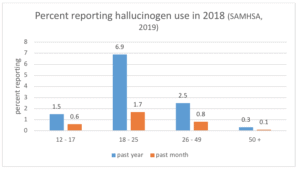History of Mescaline
Mescaline, more commonly known as peyote, has been used for over 5,000 years by Native Americans in the American southwest and Mexico, pre-succession. Mescaline is an organic compound found in different species of cacti native to the area and is revered for its psychedelic properties and commonly relied on during religious rituals. It wasn’t until 1897 that mescaline was introduced to the developed world when German chemist Arthur Heffter identified and isolated the active alkaloid of the cactus. By the mid 1950s, mescaline was a popular experimental drug among physicians, psychiatrists, and philosophers as the substance was believed to treat alcoholism and depression; however, very few studies have been done to support this. The drug was illegalized in 1970 and classified as a schedule I hallucinogenic, yet religious liberty laws allow the use of mescaline for religious purposes within the United States.

The Mescaline High
Mescaline is typically taken chewed or taken orally but can also be snorted. Mescaline produces a high in which the user experiences:
Visual and auditory hallucinations
Closed eye visualizations
Excess laughter
Euphoria
Synesthesia (seeing sounds, hearing colors, etc.)
Altered sense of time and space
Side Effects of Prolonged Mescaline Use
Long-term mescaline abuse can cause lasting effects and irreversible damage. Such side effects include:
Tremors
Chronic anxiety or depression
Panic attacks
Seizures
Amnesia
Posthallucinogenic Perception Disorder (flashbacks)
Suicidal Ideation
Mescaline Use in the United States
According to a 2016 study conducted by the National Center for Biotechnology Information, 8.0 million persons (3.0%) aged 12 or older reported using mescaline in their lifetime. According to the Substance Abuse and Mental Health Services Administration graph below, the percentage of hallucinogenic users is mainly concentrated in the young adult age range.

Mescaline Addiction Treatment
Mescaline is highly addictive and life-threatening when abused; therefore, it is extremely important to seek help immediately if you or a loved one is struggling with this addiction. At Asheville Recovery Center, treatment specialists utilize a 12-step program and practice holistic rehabilitation.
Services at the center include:
Partial Hospitalization Program – At Asheville Recovery Center we offer a partial hospitalization program for clients who need post-residential treatment as well as for clients who need primary treatment but are unable to enroll in inpatient programs. Our PHP track offers a variety of therapeutic services and benefits to individuals in early recovery from substance addiction. Our day program is full-time, offering all of the clinical hours provided in residential treatment (from 9 am to 5 pm) with the benefit of allowing clients to return home to a structured sober living environment at night. This gives individuals the opportunity to build a community of peers and practice life skills, such as cooking, cleaning, and self-care, while still participating in immersive and intensive clinical addiction and trauma treatment.
Outpatient Rehabilitation – During intensive outpatient treatment, clients live at home or in a sober living residence which can help keep them accountable for their recovery commitment. Our staff coordinates with local, reputable sober living homes to ensure that our clients are living in a safe place and that their needs are being met, even when they are not at clinical sessions. During this time, clients are also encouraged to become involved in local twelve-step fellowships, to find sponsors, and to begin working the steps of recovery through participation in these groups. IOP is a place where clients can process their experiences in twelve-step fellowships and support one another in those individual journeys.
Addiction is difficult to overcome alone. If you feel that you or a loved one is struggling with Mescaline abuse, our specialists are on standby and ready to help. Call (828)383-0784 and speak with an addiction expert today.






